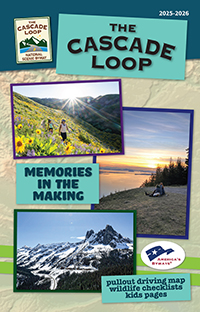
By Roni Freund -- The most common owl found on the North American continent is the great horned owl -- and they are what most people imagine when they think of owls in storybooks. They live all across the country, and are at home in secluded forest lands up to the tree line, or in busy neighborhood parks.
You may hear the great horned owl if you spend time on the Cascade Loop, as they like to nest near orchards, pastures and croplands, which are found in abundance along the byway. Throughout the year we hear owls calling to each other across the canyon where we live, late in the evening and after dark. Their distinctive “who—who” is unmistakable (but you may be fooled during the daytime when you hear Mourning doves)! The owl’s vocalization ramps up in late winter when they begin looking for mates.
We had the privilege of watching a family with three fledglings last year, in a nest that we've seen owls in over the years. Great horned owls often take over nests built by other birds, like hawks or herons, or even squirrel nests. They do not always use the same nest year after year, typically leaving it after a few years, but other owls may adopt it after it is abandoned. Nests vary widely in size, but are usually constructed with sticks and lined with bark or leaves, or even their own feathers.

A great horned owl pair will tidy the nest, and the female may lay up to 5 eggs, but 2 is more common. Much depends on the food supplies in the area. Both are involved in incubation, and once hatched the male may hunt and bring food to the nest. The adults are monogamous, but roost separately outside of breeding season.
The eggs hatch after 4 or 5 weeks, and soon you might see fluff-balls with giant eyes peeking over the nest. It takes almost two months before they begin testing their wings – nearly twice as long as it takes other owl species to start flying.
For our local populations, this ‘fledge’ activity happens mid- to late-April, so keep an eye out! If you come across any young bird species on the ground, the best thing you can do is leave it alone. Test flights are necessary for all birds, they need the opportunity to learn how to fly unmolested!

Fun Facts About Great Horned Owls:
- Petty much the only animal that will catch and eat a skunk.
- Will take down birds and mammals heavier than they are, like Osprey, Peregrine Falcon and even small dogs, cats, skunks and rabbits.
- The oldest GHO on record lived in Ohio and was at least 28 years old. Typical lifespan in the wild is about 10 years.
- Owls eyes do not move in their sockets, but instead, owls can swivel their head around to look behind them.
- The crows most dangerous predator is the GHO.
- The tufts that give the great horned owl its name are neither horns nor ears. It is believed the feathers help reflect sound and thereby their ability to hear. Their ears are actually located at the sides of their head, behind their eyes.



Nest of fledging great horned owls -- Freund's Photography
Photo's by Freund's Photography
Sources: National Geographic, Cornell Lab of Ornithology, Owl Research Institute







